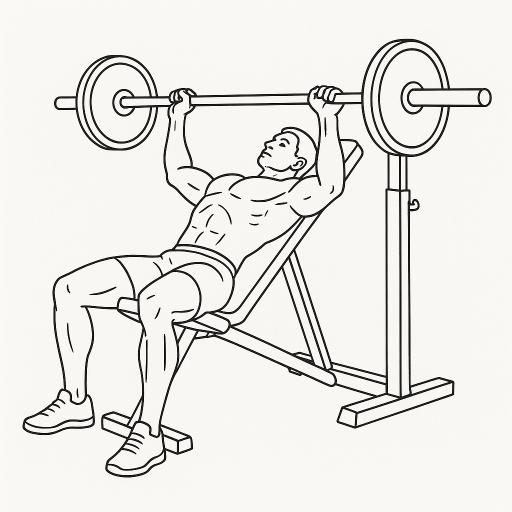Incline Bench Press
Value, Method, Muscles Worked, and Expectations

Value of the Incline Bench Press
The incline bench press is a highly effective upper body strength exercise that places greater emphasis on the upper portion of the pectoral muscles compared to the flat bench press. By positioning the bench at an incline of about 30–45 degrees, it shifts the workload toward the clavicular head of the pectoralis major. This movement also engages the shoulders and triceps, making it an excellent compound lift for developing balanced chest strength and enhancing pushing power. It is commonly included in bodybuilding, strength training, and athletic conditioning programs for its ability to build muscle mass and improve aesthetics in the upper chest area.
Method
Setup: Adjust the bench to an incline of approximately 30–45 degrees. Position the barbell at a rack height that allows you to unrack it without overextending your shoulders.
Execution:
Muscles Worked
Expectations and Training Considerations
Regularly performing the incline bench press can lead to noticeable improvements in upper chest size and strength within 6–8 weeks when combined with proper nutrition and recovery. Beginners may start with lighter weight to refine technique before progressing. For hypertrophy, aim for 3–4 sets of 8–12 repetitions. For strength, 4–6 sets of 4–6 repetitions with heavier loads are recommended. Expect some initial muscle soreness in the upper chest and front shoulders, which typically decreases as the body adapts.
Tip: Varying grip width, incline angle, and using dumbbells can further challenge the muscles and prevent plateaus.
The incline bench press is a highly effective upper body strength exercise that places greater emphasis on the upper portion of the pectoral muscles compared to the flat bench press. By positioning the bench at an incline of about 30–45 degrees, it shifts the workload toward the clavicular head of the pectoralis major. This movement also engages the shoulders and triceps, making it an excellent compound lift for developing balanced chest strength and enhancing pushing power. It is commonly included in bodybuilding, strength training, and athletic conditioning programs for its ability to build muscle mass and improve aesthetics in the upper chest area.
Method
Setup: Adjust the bench to an incline of approximately 30–45 degrees. Position the barbell at a rack height that allows you to unrack it without overextending your shoulders.
Execution:
| Step | Action |
| 1 | Lie back on the bench with feet flat on the floor for stability. |
| 2 | Grip the bar slightly wider than shoulder-width, keeping wrists straight. |
| 3 | Unrack the bar and hold it above your chest with elbows extended. |
| 4 | Lower the bar slowly to the upper chest, keeping elbows at a 45–60 degree angle. |
| 5 | Press the bar upward until arms are fully extended without locking out aggressively. |
| 6 | Repeat for the desired number of repetitions while maintaining controlled form. |
| Primary Muscles | Secondary Muscles |
| Pectoralis major (upper/clavicular head) | Anterior deltoids |
| Triceps brachii | Serratus anterior |
| Upper trapezius |
Regularly performing the incline bench press can lead to noticeable improvements in upper chest size and strength within 6–8 weeks when combined with proper nutrition and recovery. Beginners may start with lighter weight to refine technique before progressing. For hypertrophy, aim for 3–4 sets of 8–12 repetitions. For strength, 4–6 sets of 4–6 repetitions with heavier loads are recommended. Expect some initial muscle soreness in the upper chest and front shoulders, which typically decreases as the body adapts.
Tip: Varying grip width, incline angle, and using dumbbells can further challenge the muscles and prevent plateaus.
Updated: August 13, 2025 10:19
Comments
You must log in to post a comment.